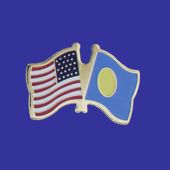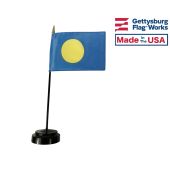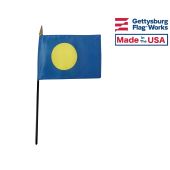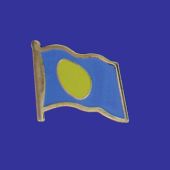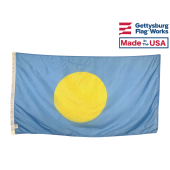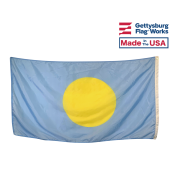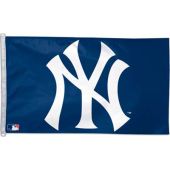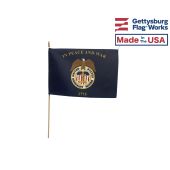Buy Palau Flags

Flag of Palau
Palau has used a wide variety of flags over the years, but only one of them has been entirely unique to the nation. Every other Palau flag has also represented another, larger nation or organization that has held power over the islands. The modern Palaun flag is a very recent design, but its relative youth has not prevented it from becoming a strong symbol of independence for the people of Palau.
- Capital of Palau: Koror
- Area of Palau: 458 sq. km
- Languages used in Palau: Palauan (official), Sonsoralese, English, Tobi, Angaur, Japanese, Filipino, Chinese, Carolinian, other Asian
- Religions in Palau:Roman Catholic, Protestant, Modekngei, Seventh-Day Adventist, Jehovah's Witness, Latter-Day Saints
Colors and Symbolism of the Palaun Flag
The Palaun flag has a light blue field that displays a yellow circle. The circle is placed near the center of the flag, but it is offset slightly towards the hoist. The blue field represents the nation's independence, and some sources all say that it represents the ocean that surrounds the islands of Palau. The circle represents the full moon, which is considered a sign of good luck and an excellent time for most activities in the traditional culture of the islands. It also represents peace, love, and tranquility.
History of the Palau Flag
Palau first began to use flags during the colonial period. The first Palau flag was the flag of Spain, which came into use in the region during the middle of the 16th century. It remained in use until 1899, at which point Spain ceded control of the last of its holdings in Palau to Germany. The German flag had already begun to fly over some of the islands in 1885, but the German Empire only gained complete control over the area after that transfer of power. Palau passed to Japanese control in 1914, at which point the islands began to use the flag of Japan.
Japan lost control over the islands in 1944, at which point they began to use the flag of the United States. The American flag would fly over the islands until shortly after they gained their complete independence, but that was not the only flag used during that period. The flag of the United Nations came into use alongside the American flag in 1947, and it was replaced by the flag of the Trust Territory of the Pacific Islands in 1967. It fell out of use when the nation gained its independence in 1981, and the nation adopted the modern flag at the same time. The American flag remained in use alongside the flag of Palau until 1994 due to the close association between the two states.
